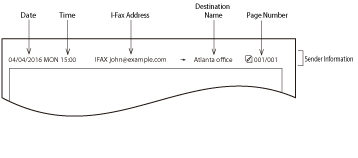| User's Guide (Product Manual) | |
|---|---|
| User's Guide (Product Manual) | |
|---|---|
IMPORTANT |
If you use the machine without registering the necessary information correctly, the machine may not function properly. |

<Time Zone>: | The standard time zones of the world are expressed globally in terms of the difference in hours (± up to 12 hours) from GMT*1 (± 0 hours). A time zone is a region throughout which this time difference is the same. |
<Daylight Saving Time>: | In some countries, time is temporarily advanced throughout the summer season. This practice is called "Daylight Saving Time." |
NOTE |
You can set the machine so that the sending record is not printed. (See "Printing the TX Terminal ID.") If you set the machine to print the sending record at the top of the recording paper, and not all of the items are registered, only the registered items and the total number of original pages are printed. To print the destination's name on the recipient's paper, set <Display Destination Unit Name> to 'On' in [TX Terminal ID]. You can specify to automatically synchronize the date and time with a server on the network. (See "Settings Common to TCP/IPv4 and TCP/IPv6.") If the Local Device Authentication user authentication system of SSO-H is set as the login service and you are sending an e-mail message: The e-mail address of the login user registered for the Local Device Authentication user authentication system of SSO-H appears in the From field on the e-mail recipient's machine, instead of the e-mail address registered in the Device Information settings for this machine. The e-mail address that you registered in the Device Information settings for this machine appears in the From field on the I-fax recipient's machine. The e-mail address of the login user registered for the Local Device Authentication user authentication system of SSO-H is displayed in the Sender field. If the Server Authentication user authentication system of SSO-H is set as the login service and you are sending an e-mail message (including when performing Server Authentication with the 'Server Authentication + Local Device Authentication' user authentication system): The e-mail address that is set for the logged-in user using the Server Authentication appears in the From field on the recipient's machine, instead of the e-mail address that you registered in the Device Information settings for this machine. The e-mail address that you registered in the Device Information settings for this machine appears in the From field, and the e-mail address that is set for the logged-in user using the Server Authentication is displayed in the Sender field on the recipient's machine. If you set [Set Authentication User Dest. to Sender] to 'On' in E-Mail/I-Fax Settings, the e-mail address of the login user appears in the From field on the recipient's machine, regardless of the login service. If you set [Set Authentication User Dest. to Sender] to 'Off', the address registered in the Device Information settings is displayed instead. For instructions on storing your machine's e-mail address, see "Common Communication Settings for E-Mail/I-Fax." |
